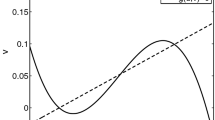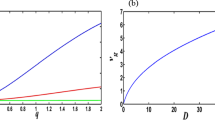Abstract
The FitzHugh equations have been used as a caricature of the Hodgkin–Huxley equations of neuron firing and to capture, qualitatively, the general properties of an excitable membrane. The spatial propagation of neuron firing due to diffusion of the current potential was described by the FitzHugh–Nagumo model. Assuming that the spatial propagation of neuron firing is caused by not diffusion but cross-diffusion connection between the potential and recovery variables the cross-diffusion version of the FitzHugh model gives rise to the typical fast traveling wave solutions characteristic to the FitzHugh model, and additionally gives rise to the slow traveling wave solutions exhibited in the diffusion FitzHugh–Nagumo equations (Berezovskaya et al., Math Biosci Eng 5:239–260, 2008).
In this paper the FitzHugh model with both diffusion and cross-diffusion terms is studied; it is shown that this new version of spatial FitzHugh model gives rise to fast and slow traveling impulses.
Access this chapter
Tax calculation will be finalised at checkout
Purchases are for personal use only
Similar content being viewed by others
References
Sherwood, L.: Human Physiology: From Cells to Systems, 4th edn. Brooks and Cole, Belmont, CA (2001)
Hodgkin, A.L., Huxley, A.F.: A quantitative description of membrane current and its application to conduction and excitation in nerve. J. Physiol. 117, 500–544 (1952)
FitzHugh, R.: Impulses and physiological states in theoretical models of nerve membrane. Biophys. J. 1, 445–466 (1961)
FitzHugh, R.: Mathematical models of excitation and propagation in nerve. In: Schwan, H.P. (ed.) Biological Engineering. McGraw-Hill, New York (1969)
Nagumo, J., Arimoto, S., Yoshizawa, S.: An active pulse transmission line simulating nerve axon. Proc. IRE 50, 2061–2070 (1962)
Berezovskaya, F., Karev, G.: Bifurcation approach to analysis of travelling waves in some Taxis–Cross-Diffusion models. Math. Model. Nath. Phenom. 8(3), 133–153 (2013)
Evans, J., Fenichel, N., Feroe, J.: Double impulse solutions in nerve axon equations. SIAM J. Appl. Math. 42, 219–234 (1982)
Guckenheimer, J., Krauskopf, B., Osinga, H.M., Sanstede, B.: Invariant manifolds and global bifurcations. CHAOS 25, 097604 (2015)
Hastings, S.P.: On the existence of homoclinic and periodic orbits for the FitzHugh-Nagumo equations. Quart. J. Math. (Oxford) 27, 123–134 (1976)
Ieda, M., Mimira, M., Ninomia, H.: Diffusion, cross-diffusion and competitive interaction. J. Math. Biol. 53, 617–641 (2006)
Khibnik, A., Krauskopf, B., Rousseau, C.: Global study of a family of cubic Lienard equations. Nonlinearity 11, 1505–1519 (1998)
Kostova, T., Ravindran, R., Schonbek, M.: FitzHugh-Nagumo revisited: types of bifurcations, periodical forcing and stability regions by a Lyapunov functional. Int. J. Bifurcation Chaos 14, 913–925 (2004)
Kuznetsov, Y.: Elements of Applied Bifurcation Theory. Applied Mathematics Sciences. Springer, Berlin (1995)
Volokitin, E.P., Treskov, S.A.: Parameter portrait of FitzHugh system. Math. Model. 6(12), 65–78 (1994) (in Russian)
Volpert, A.I., Volpert, V.A., Volpert, V.A.: Travelling Wave Solutions of Parabolic Systems. AMS, Providence, RI (1994)
Almirantis, Y., Papageorgiou, S.: Cross-diffusion effects on chemical and biological pattern formation. J. Theor. Biol. 151, 289–311 (1991)
Berezovskaya, F., Camacho, E., Wirkus, S., Karev, G.: Traveling wave solutions of FitzHugh model with cross-diffusion. Math. Biosci. Eng. 5(2), 239–260 (2008)
Berezovskaya, F.S., Karev, G.P.: Bifurcations of traveling waves in population models with taxis. Physics-Uspekhi 169(9), 1011–1024 (1999)
Berezovskaya F., Novozhilov A., Karev G.: Pure cross-diffusion models: implications for traveling wave solutions. Dynam. Contin. Discret. Impulsive Syst. (Ser. A) 16(S1), 141–146 (2009)
Biktashev, V., Tsyganov, M.: Solitary waves in excitable systems with cross-diffusion. Proc. R. Soc. A 461, 3711–3730 (2005)
Kuznetsov, Y., Antonovsky, M., Biktashev, V., Aponina, E.: A cross-diffusion model of forest boundary dynamics. J. Math. Biol. 32, 219–232 (1994)
Sherratt, J.: Travelling wave solutions of a mathematical model for tumor encapsulation. SIAM J. Appl. Math. 60(2), 392–407 (2000)
Tsyganov, M.A., Biktashev, V.N., Brindley, J., Holden, A.V., Ivanitskii, G.R.: Waves in systems with cross-diffusion as a new class of nonlinear waves. Physics-Uspekhi 177(3), 275–300 (2007)
Zemskov, E.P., Epstein, I.R., Muntean, A.: Oscillatory pulses in FitzHugh-Nagumo type systems with cross-diffusion. Math. Med. Biol. 28(2), 217–226 (2011)
Verzi, W., Rheuben, M.B., Baer, S.M.: Impact of time-dependent changes in spine density and spine change on the input–output properties of a dendritic branch: a computational study. J. Neurophysiol. 93, 2073–2089 (2005)
Highfield R.: The brains teasing chemical cocktail that gets us drunk. UK News, Electronic Telegraph, Issue 582 (1996)
Hoppensteadt, F.: Singular perturbations on the infinite interval. Trans. Amer. Math. Soc. 123, 521–535 (1966)
Tikhonov, N.: Systems of differential equations containing small parameters multiplying the derivatives. Matematicheskii sbornik 31, 575–586 (1952)
Dangelmayr, G., Guckenheimer, J.: On a four parameter family of planar vector fields. Arch. Ration. Mech. Anal. 97, 321–352 (1987)
Dumortier, F., Rossarie, R., Sotomayor, J.: Bifurcations of planar vector fields. Lect. Notes Math. 1480, 1–164 (1991)
Wiggins, S.: Introduction to Applied Non-Linear Dynamical Systems and Chaos. Springer, New York/Berlin/Heidelberg (1990)
Ni, W.-M.: Diffusion, cross-diffusion and their spike-layer steady states. Not. Am. Math. Soc. 45(1), 9–18 (1998)
Murray, J.D.: Mathematical Biology. Springer, New York (1993)
Author information
Authors and Affiliations
Corresponding author
Editor information
Editors and Affiliations
Appendix
Appendix
1.1.1 Lienard Form of the FitzHugh Model andItsWaveSystem
Through the change of variables
the local model (1.1) is transformed to the generalized Lienard form:
Where
Model (1.2) after transformation (1.10) reads
Model (1.3) after transformation (1.10) reads
A traveling wave solution of systems (1.12) and (1.13) is defined as a pair of bounded functions
where \( C>0 \) is a velocity of propagation.
Let’s now replace the capital letters in (1.9) with small letters, reduce p and q via
\( p=\left(u+v\right)/{k}_1,\kern0.36em q=u-{k}_2,\kern0.24em {k}_1\ne 0 \).
Take into the consideration that \( {u}_t=C{u}_{\xi },\kern0.24em {u}_x={u}_{\xi };\;{v}_t=C{v}_{\xi },\kern0.24em {v}_x={v}_{\xi };\kern0.36em {u}_{xx}={u}_{\xi \xi }={v}_{\xi }/C \) and put \( w={v}_{\xi },{w}_{\xi }={v}_{\xi \xi } \) we get the wave system of system (1.12) in the form
where \( \varPhi \left(U,V\right)=f(U) + V\left({g}_1(U)+VG\left(U,V\right)\right) \) and functions f(u), g 1(u) , G(u, v) are given by (1.11).
The wave system of (1.13) takes the form
System (1.15) contains the factor \( 1/\alpha \equiv \left(eC-{D}_Q{k}_1\right)/C\Big) \) which we assumed to be non-zero.
Behaviors of system (1.15) depend on the sign of parameter α. For \( \alpha >0 \) there exists a parameter domain containing point \( M\left(e=1,{k}_1=0,{k}_2=1\right) \), where the vector field defined by system (1.15) is topologically orbitally equivalent to those defined by local system (1.1). It realizes the bifurcation of co-dimension 4 with symmetry (“spiral case”) [11]. For \( \alpha <0 \) parameter point \( M\left(e=1,{k}_1=0,{k}_2=1\right) \) is also the point that corresponds to the bifurcation of co-dimension four with symmetry but as a “saddle case.” So, behaviors of system (1.15) for \( \alpha >0 \) are different from those for \( \alpha <0 \) (see details in [17]).
Rights and permissions
Copyright information
© 2016 Springer International Publishing Switzerland
About this paper
Cite this paper
Berezovskaya, F. (2016). Traveling Waves Impulses of FitzHugh Model with Diffusion and Cross-Diffusion. In: Toni, B. (eds) Mathematical Sciences with Multidisciplinary Applications. Springer Proceedings in Mathematics & Statistics, vol 157. Springer, Cham. https://doi.org/10.1007/978-3-319-31323-8_1
Download citation
DOI: https://doi.org/10.1007/978-3-319-31323-8_1
Published:
Publisher Name: Springer, Cham
Print ISBN: 978-3-319-31321-4
Online ISBN: 978-3-319-31323-8
eBook Packages: Mathematics and StatisticsMathematics and Statistics (R0)




